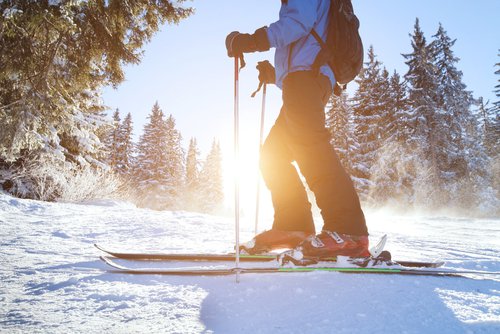
Skiing is one of the most beloved forms of winter fun. However, it can also be dangerous. According to the US Consumer Product Safety Commission, more than 144,000 downhill skiing-related injuries were treated in 2010 between hospitals, emergency rooms and doctors’ offices across the country.
Cross country skiing is a beloved winter activity, but it comes with its risks. In 2010, more than 144,000 injuries related to downhill skiing were treated across the US. At Barrington Orthopedic Specialists, we prioritize the safety of athletes and hobbyists alike. Here are four ways to stay safe while enjoying cross country skiing and prevent common skiing injuries.
Know Your Risks of Injury
Because falls and collisions during skiing can occur in various locations, they can result in different types of injuries. Alpine skiers and those participating in nordic skiing may experience a range of orthopedic injuries. Common injuries sustained by skiers include:
- Knee injuries, particularly affecting the anterior cruciate ligament.
- Shoulder injuries, such as dislocations and sprains, often caused by reaching out to break a fall.
- Fractures in the shoulder and lower leg.
- Head injuries, which should be treated as a medical emergency.
In addition to these injuries, upper extremity injuries are also a concern for skiers, particularly alpine skiers. It is important to be aware of the potential risks associated with skiing and take appropriate precautions to minimize the likelihood of injury.
Choose the Appropriate Equipment
The gear you choose for skiing is crucial as it can impact your performance and safety on the slopes. It can even determine whether you have a fun day in the snow or end up with a serious injury. When it comes to skiing, it's important to prioritize appropriate clothing. Opt for light, loose-fitting layers that are resistant to wind, water, and provide warmth.
Additionally, ensure your footwear meets the safety and appropriateness standards set by the American Society of Testing and Materials (ASTM). This includes ski boots that are approved by ASTM. Bindings should also be adjusted properly based on your personal height and weight. Don't forget to equip yourself with ski goggles and a ski helmet, which are essential for protection. Remember, using the right ski helmet is crucial to your safety, so avoid substituting it with a bike or skateboarding helmet. When discussing ski injuries, it's important to note the most common ski injuries and take necessary precautions to prevent them.
Go to the Slopes Prepared
If you're planning a ski trip, it's important to take some precautions to prevent injuries, especially spinal injuries which can occur during ski jumping. By following these tips, you can minimize the risk of the most common skiing injuries:
- Pace yourself and take regular breaks to avoid overexertion, especially during ski jumping.
- Prioritize your fitness and gradually increase the difficulty of runs to avoid straining your body.
- Stay hydrated by drinking water frequently, both during and after skiing.
- Warm up properly before skiing to prepare your muscles and increase blood flow, reducing the chances of getting injured.
- Ski within your skill level and avoid overdoing it, especially when attempting ski jumps.
If you're new to skiing, it's highly recommended to take a few lessons to learn the basic techniques. This will not only improve your safety on the slopes but also reduce the risk of spinal injuries associated with ski jumping. Stay safe and enjoy your time on the slopes!
Practice Safe Skiing
When skiing at a resort or park, it's crucial to follow a strict set of rules to ensure your safety and prevent common injuries, including head injuries. Additionally, there are general safety guidelines for skiing that you should learn and adhere to, such as how to safely stop, merge, and yield to other skiers on the trail. It's also important to be mindful of your surroundings since you're outdoors. Check the weather conditions before heading out and stay on the designated trail while avoiding marked-off areas. Lastly, always be cautious when using ski lifts to ensure a safe and enjoyable experience.
Skiing should never be done without a partner, and partners should stick together and wait for one another if someone falls behind.
If you’ve sustained an orthopedic injury while skiing, the sports medicine experts at Barrington Orthopedic Specialists are here to help you get the treatment you need, To be scheduled with a physician at Barrington Orthopedic Specialists, contact our office at (847) 285-4200 or schedule online here.
For urgent needs when our physician’s offices are closed, visit our Immediate Orthopedic Care (IOC) in Schaumburg, Illinois.
